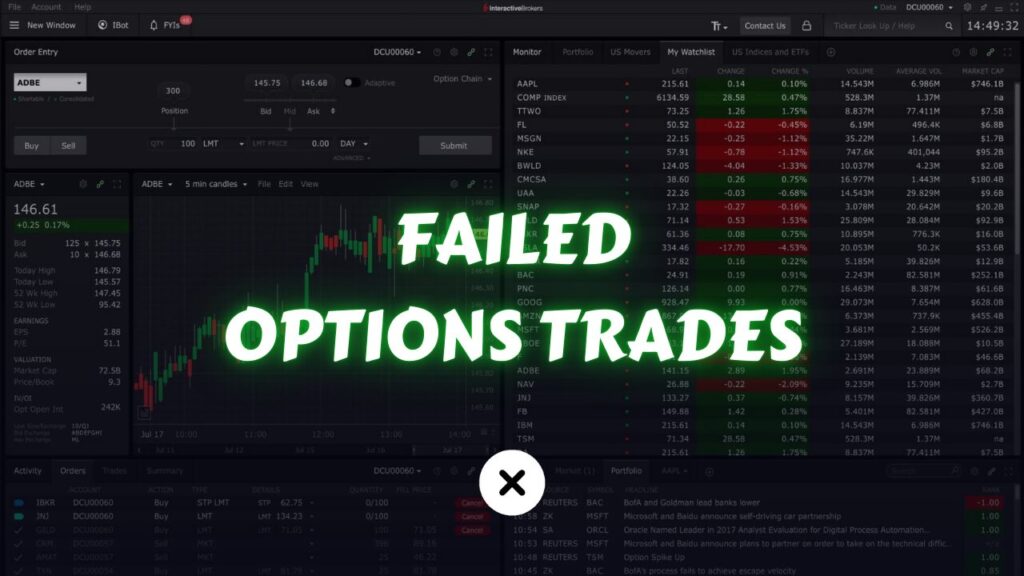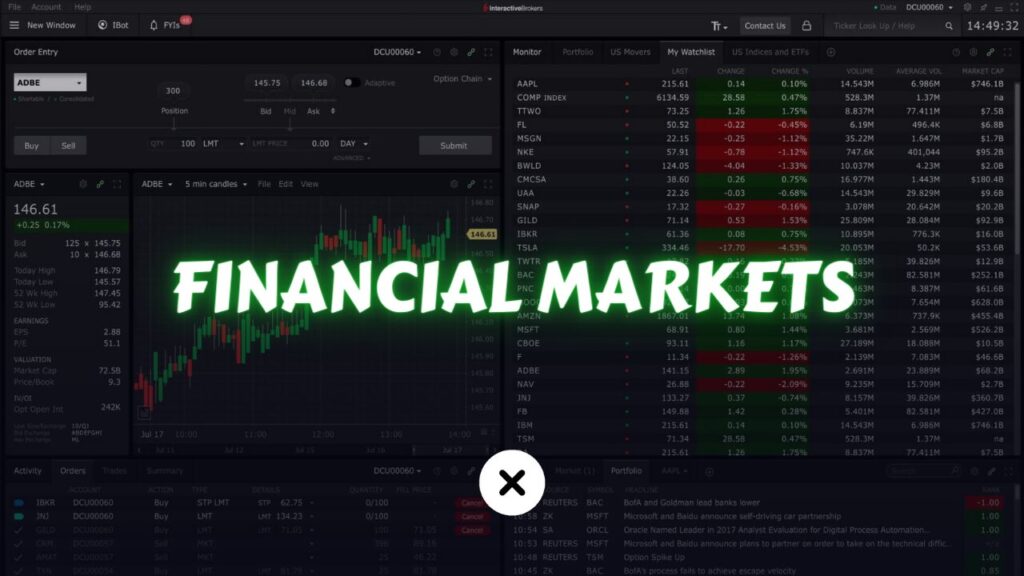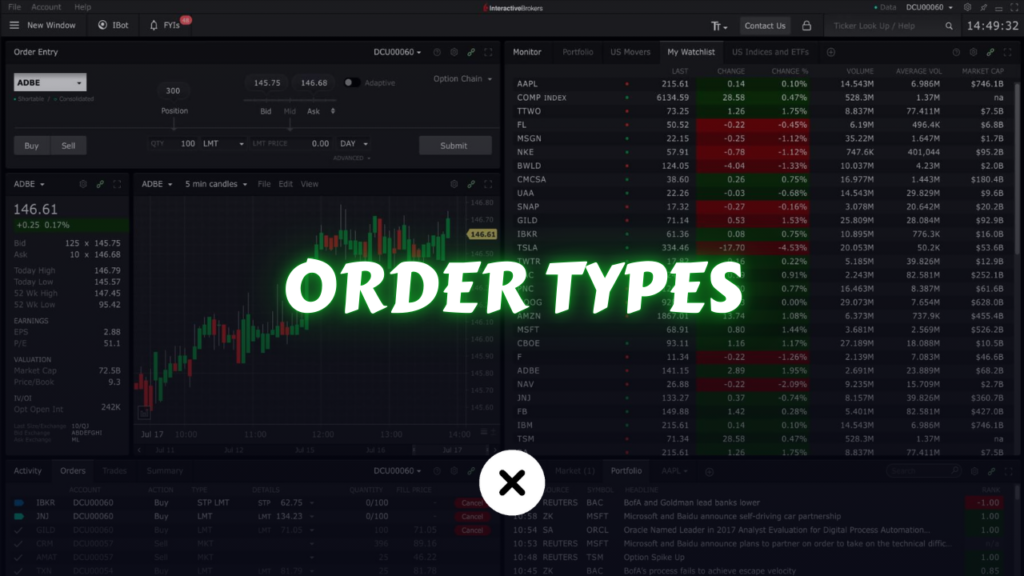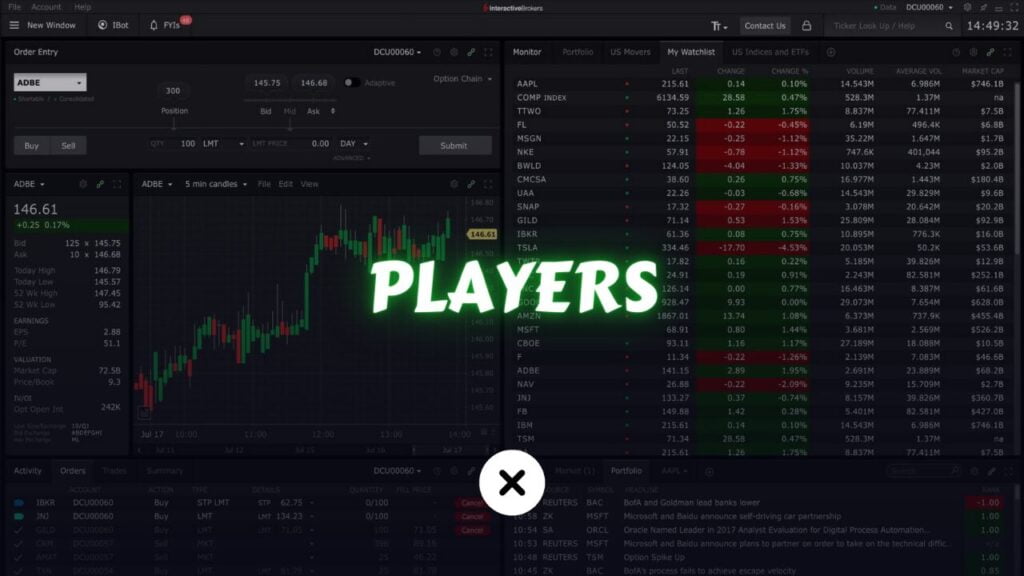Options trading can be an exciting avenue for generating profits, hedging portfolios, and expressing market views with limited risk capital. However, it is also notoriously complex and often intimidating for newcomers. Even seasoned traders occasionally find themselves on the wrong side of a trade. In many instances, options trades fail not solely due to bad luck, but due to a combination of preventable mistakes, inadequate knowledge, poor planning, and flawed execution. Understanding what goes wrong in failed options trades is critical for any trader looking to refine their strategy, protect capital, and ultimately improve their long-term performance.
In this in-depth article, we will analyze the common reasons why options trades fail. We will explore the psychological hurdles traders face, the mechanical aspects of pricing and Greeks, the pitfalls of poor risk management, and how inadequate research can lead to costly errors. We’ll also offer practical tips and key takeaways that can help you turn these lessons into more informed trading decisions. By the end, you will have a detailed roadmap that helps you avoid common pitfalls and positions you for greater success in the volatile world of options trading.
Understanding Options: A Brief Overview

Before we dive into why options trades fail, let’s ensure we fully understand what options are and why traders use them. Options are derivative contracts that give the buyer the right—but not the obligation—to buy or sell an underlying asset, such as a stock or an index, at a specified strike price before or on a given expiration date. The two primary types of options are:
- Call Options: These give the holder the right to buy the underlying asset at the strike price.
- Put Options: These give the holder the right to sell the underlying asset at the strike price.
Traders are attracted to options for several reasons. They can provide leverage, allowing traders to control a larger position with a smaller upfront investment than buying or selling the underlying asset outright. Options also offer ways to structure complex positions that might protect against market downturns or profit from sideways markets. Yet, this versatility and complexity come at a cost: the need for in-depth knowledge to execute trades successfully.
Common Reasons Options Trades Fail

When an options trade fails, it usually does so due to a combination of factors rather than a single, isolated mistake. Below are some of the most common issues traders face:
- Lack of a Solid Trading Plan
- Over-leveraging and Poor Position Sizing
- Ignoring the Greeks
- Misjudging Implied Volatility
- Inadequate Risk Management
- Emotional Decision-Making
- Overconfidence and Lack of Continuous Learning
- Insufficient Research on the Underlying Asset
- Ignoring Market Conditions and Macro Factors
- Failure to Adapt and Adjust Strategies
We will explore each of these topics in detail, illustrating how they contribute to failed trades and what you can do to address them.
1. Lack of a Solid Trading Plan
What Often Goes Wrong:
One of the most frequent reasons for failed options trades is entering the market without a clear and well-defined plan. Many traders jump into options lured by potential high returns but fail to define their entry and exit points, their risk tolerance, and their criteria for trade adjustments.
Explanation:
A trading plan acts as a roadmap. It should outline the type of options strategies you’re comfortable with (e.g., vertical spreads, iron condors, simple call or put buys), the criteria under which you initiate a trade (technical indicators, fundamental valuation, or a volatility-based premise), and your risk management rules (stop-loss levels, position sizing, and diversification). Without this blueprint, traders may be guided by impulses and market noise. This often leads to rash decision-making, holding onto losing positions too long, or failing to capitalize on winning trades by exiting prematurely.
Example:
Imagine initiating a long call position simply because a stock has been rising for a few days without stating your profit target or defining when you should exit if the trade moves against you. If the underlying’s trend suddenly reverses, you find yourself lost and panicked, often leading to late exits and larger-than-necessary losses.
Key Takeaway:
Always have a written trading plan that clearly states your objectives, strategies, risk parameters, and trade management rules. Refer to it before, during, and after every trade.
2. Over-leveraging and Poor Position Sizing
What Often Goes Wrong:
Options inherently provide leverage, allowing traders to control a significant amount of the underlying asset for relatively small upfront capital. While leverage can amplify gains, it can also magnify losses if misused. Many failed trades stem from taking on too large a position relative to one’s account size, risking substantial capital on a single bet.
Explanation:
Over-leveraging leads to intense emotional stress and prevents rational decision-making. With too large a position, even a small adverse move in the underlying can result in an alarming percentage loss of your trading capital. This can trigger a cascade of bad decisions—doubling down, panic selling, or clinging to losing positions in the hope of a turnaround.
Example:
Consider buying ten contracts of an at-the-money call option for a volatile tech stock with a relatively small account. If the stock unexpectedly moves against you, the value of your options might drop rapidly. Due to the large position size, the net loss could be crippling, wiping out a significant chunk of your portfolio.
Key Takeaway:
Limit each trade to a manageable portion of your portfolio, such as 1-5% of your total trading capital. This helps ensure a single bad trade won’t destroy your entire account.
3. Ignoring the Greeks
What Often Goes Wrong:
Options pricing is influenced by several variables collectively known as the Greeks: Delta, Gamma, Theta, Vega, and Rho. Traders who ignore these Greeks often fail to understand how their position’s value changes with underlying price movements, volatility shifts, and time decay.
Explanation:
- Delta: Measures how much the option’s price changes with a $1 move in the underlying asset. Not understanding Delta can cause traders to misjudge how much profit or loss to expect from a given price move.
- Gamma: Shows how much Delta changes as the underlying’s price moves. Traders who ignore Gamma might be caught off-guard by how quickly their positions gain or lose sensitivity to price changes.
- Theta: Represents time decay, the daily erosion in option value as expiration approaches. Overlooking Theta can lead to holding options too long, watching as they slowly lose value with no favorable move.
- Vega: Measures sensitivity to changes in implied volatility (IV). Ignoring Vega may cause you to hold positions that rapidly lose value if volatility drops unexpectedly.
- Rho: Though less commonly discussed (especially in short-term trades), it reflects the sensitivity of options to interest rate changes, which can matter in certain macro environments.
Example:
Buying an at-the-money call option just before a company’s earnings announcement without considering how implied volatility might drop post-earnings (a Vega effect) could result in a loss even if the stock moves in the anticipated direction.
Key Takeaway:
Familiarize yourself with the Greeks and use them to inform trade selection, position management, and exit strategies. Understanding these metrics ensures you know how your option’s value changes and helps prevent surprises.
4. Misjudging Implied Volatility
What Often Goes Wrong:
Many options trades fail because the trader either overpays for options when implied volatility is high or sells options when implied volatility is low, leaving money on the table.
Explanation:
Implied volatility (IV) reflects the market’s expectation of how much the underlying asset will move over a certain period. High IV makes options more expensive, while low IV reduces their premium. Traders who ignore IV may buy overpriced options that require an outsized move in the underlying just to break even. Conversely, selling options when IV is relatively low reduces potential premium income.
Example:
If you buy a call option ahead of a major news event at peak IV, the underlying stock might still move in your favor after the announcement. Yet, because IV typically crashes post-event (the “vol crush”), your option might lose value despite the favorable move in the underlying price.
Key Takeaway:
Always check the implied volatility relative to historical levels before initiating a trade. Consider strategies appropriate for the current volatility environment—buying options in low IV environments and selling options when IV is relatively high.
5. Inadequate Risk Management
What Often Goes Wrong:
Failing options trades often have a common denominator: poor risk management. This includes not setting stop-loss orders, not defining maximum acceptable losses before entering a trade, and not using position-sizing rules.
Explanation:
Risk management is about controlling losses and preserving capital. Without it, a single large loss can eradicate months of steady gains. For options traders, risk management might include using spreads to limit potential losses, setting alerts to close positions if the underlying hits a certain level, or employing stop-loss orders and mental stop levels.
Example:
If you buy a naked call option and the underlying stock plummets, you might watch the option’s value evaporate. Without a predetermined exit point or a well-defined loss threshold, you could end up holding the position until expiration, resulting in a complete loss of the premium paid.
Key Takeaway:
Implement a clear set of risk management rules. Decide on a maximum loss amount per trade and strictly adhere to it. By doing so, you not only protect your capital but also maintain emotional discipline.
6. Emotional Decision-Making
What Often Goes Wrong:
Emotions such as fear, greed, hope, and panic frequently lead to failed trades. Traders who base decisions on feelings rather than analysis are prone to chasing losing trades, exiting winners too early, or making impulsive moves based on market noise.
Explanation:
Emotional control is a critical skill in trading. Fear can prevent you from entering a valid trade setup; greed can push you into risky positions that don’t fit your plan. Hope can cause you to hold onto losing trades beyond reason, and panic can lead you to exit winning positions prematurely. Over time, these emotional swings lead to inconsistent results and losses.
Example:
After suffering a series of losing trades, a trader may refuse to exit a current losing position, hoping it will reverse to “make back” previous losses. This emotional reasoning often turns a small, manageable loss into a catastrophic one.
Key Takeaway:
Develop a disciplined, rules-based approach to trading. Recognize your emotional triggers and practice techniques—such as pre-trade checklists or journaling—that help maintain objectivity.
7. Overconfidence and Lack of Continuous Learning
What Often Goes Wrong:
Some traders enjoy early success and become overconfident. This overconfidence can manifest as taking larger risks, neglecting research, or ignoring their trading plan. Eventually, market conditions change, and without continuous learning, these traders find themselves unprepared.
Explanation:
Options markets evolve. Volatility patterns shift, liquidity conditions change, interest rates move, and new market sectors emerge. Traders who assume they’ve mastered the game stop learning and improving. Overconfidence blinds them to risk and to the subtle clues that it might be time to adjust their strategy.
Example:
A trader who profited by selling put spreads in a low-volatility environment might assume the same strategy works indefinitely. When volatility spikes and underlying prices become more erratic, failing to update their strategy leads to bigger losses.
Key Takeaway:
Adopt a student’s mindset. Continuously study market trends, adjust strategies, and learn from both successful and failed trades. Regularly review your performance and remain humble.
8. Insufficient Research on the Underlying Asset
What Often Goes Wrong:
Options are derivatives, so their value is intrinsically linked to the performance of the underlying asset. Many traders fail because they treat the option as a standalone product without sufficiently understanding the stock, commodity, or index it represents.
Explanation:
Thorough research involves fundamental analysis (assessing financial health, industry conditions, growth prospects) and technical analysis (examining price action, support/resistance levels, and momentum indicators). Ignoring either can lead to taking options positions on companies that are overvalued, in declining sectors, or facing upcoming news events that could dramatically move prices.
Example:
Buying calls on a retail stock without realizing that the company’s earnings are due soon and market expectations are low could backfire if the earnings report disappoints. The stock might plunge, taking your call option value down with it.
Key Takeaway:
Always analyze the underlying asset’s fundamentals and technicals before initiating an options trade. Understanding what drives the underlying’s price movement is crucial to selecting the right strike and expiration.
9. Ignoring Market Conditions and Macro Factors
What Often Goes Wrong:
Traders sometimes fail to consider broader market conditions—overall market sentiment, economic indicators, interest rates, and geopolitical events. Ignoring these factors can lead to trades that are fundamentally misaligned with the general direction of the market.
Explanation:
Options traders who fixate solely on a single stock may miss the forest for the trees. For instance, if the broader market is trending downward due to recession fears, buying call options on a growth stock without acknowledging the bearish environment can be risky.
Example:
Imagine betting heavily on call options in a high-interest-rate environment where investors are rotating out of growth stocks into safer, dividend-paying equities. Without factoring in the macro conditions, your bullish position may falter, not due to company-specific news, but due to broader market sentiment.
Key Takeaway:
Regularly assess the overall market environment, monitor key economic indicators (like inflation, GDP growth, employment data), and stay informed about major global events. Aligning your options trades with the prevailing macro backdrop can significantly improve their success rate.
10. Failure to Adapt and Adjust Strategies
What Often Goes Wrong:
Options trading strategies are not one-size-fits-all. Markets are dynamic and conditions evolve. Traders who fail to adapt and adjust their strategies accordingly often find themselves on the losing end of trades.
Explanation:
A strategy that excels in a low-volatility, bullish market environment may fail in a high-volatility, range-bound market. Knowing when to switch from debit spreads to credit spreads, from buying options to selling premium, or from directional plays to delta-neutral strategies is a hallmark of a skilled options trader.
Example:
If your go-to strategy is buying long calls in a hot tech market and volatility suddenly spikes due to geopolitical tensions, that strategy might no longer be optimal. Failing to shift toward credit spreads or iron condors may result in persistent losses.
Key Takeaway:
Continuously evaluate the effectiveness of your chosen strategies in the current market conditions. Adapt, tweak, or even overhaul your approach when necessary to stay aligned with changing market dynamics.
Learning from Failed Trades

What Often Goes Wrong if Lessons are Not Learned:
It’s one thing to fail on a trade; it’s another to fail to extract value from that experience. Traders who do not analyze their mistakes and identify what went wrong will likely repeat the same errors.
Maintain a trading journal where you record your trade rationale, entry and exit points, and the outcome. After the trade, review what happened and why. Did you ignore the Greeks? Did you over-leverage? Was your time horizon too short or too long? By dissecting losing trades, you gain insights that can prevent similar mistakes in the future.
Example:
After losing money on a put spread trade, you review your notes and realize you entered the trade right before a major earnings announcement, ignoring the volatility crush that followed. Armed with this knowledge, you vow never to trade options around earnings without factoring in IV behavior.
Key Takeaway:
Treat every loss as tuition for your trading education. Reflect on what went wrong, and adjust your plan and strategies accordingly. Continuous improvement can turn past failures into future successes.
Practical Steps to Improve Your Options Trading

To avoid repeating the mistakes that lead to failed trades, consider the following action steps:
- Create and Follow a Written Plan:
Include specifics about entry criteria, exit conditions, risk management rules, and acceptable strategies. - Study the Greeks and Volatility:
Make sure you understand how Delta, Gamma, Theta, and Vega impact your trade, and analyze implied volatility relative to historical volatility before executing. - Position Sizing:
Keep positions small relative to your portfolio. Use a rule of thumb, such as risking no more than 1-5% of your capital on any single trade. - Risk Management Tools:
Consider using spreads instead of naked options, set stop-loss orders, and have predefined profit targets. - Emotional Discipline:
Use checklists, trading journals, and even mindfulness techniques to maintain emotional balance. Avoid trading based on news headlines or social media hype without proper analysis. - Ongoing Education:
Regularly update your knowledge about market conditions, new trading strategies, and changes in the macroeconomic environment. Consider courses, webinars, or mentorship programs. - Diversify Strategies and Underlyings:
Don’t rely on one type of trade or one sector. Experiment with different strategies—iron condors, calendar spreads, covered calls—across various sectors to spread out risk. - Backtesting and Paper Trading:
Test new strategies in a risk-free environment before committing real capital. Paper trading allows you to gain confidence and refine your approach.
Key Takeaways

- Knowledge and Planning are Paramount:
Successful options trading starts with a solid plan and a deep understanding of how options work. Without a comprehensive plan, you’ll be trading on guesswork and intuition, which can lead to failure. - Risk Management is Non-Negotiable:
Proper position sizing, setting maximum loss thresholds, and using protective strategies are crucial to long-term survival in the market. - Emotions Must be Kept in Check:
Trading on feelings is a recipe for inconsistent and often disastrous results. Strive to remain disciplined and objective. - Continuous Learning is Essential:
Markets change, and so should you. Never stop learning and adapting. Those who fail to evolve will likely fail in their trades. - Focus on Underlying Fundamentals and Macro Conditions:
Your options strategy should be aligned with the reality of the stock, the sector, and the broader market environment. - Analyze Every Loss:
Failed trades offer valuable lessons. Review them to identify what went wrong, and use that knowledge to avoid repeating the same mistakes.
Conclusion
Failed options trades are an inevitable part of the learning curve for both new and experienced traders. However, they do not have to define your trading journey. By understanding why trades fail—whether it’s due to poor planning, ignoring the Greeks, misjudging implied volatility, inadequate risk management, emotional decision-making, or some combination thereof—you can take concrete steps to prevent these errors from recurring.
A disciplined, informed, and continuously evolving approach to options trading can turn these failures into stepping stones toward better performance. The key is to remain humble, embrace a learning mindset, and methodically apply the insights gained from past mistakes. With patience, practice, and persistence, you can significantly reduce the incidence of failed options trades and set yourself on a path toward consistent success.




